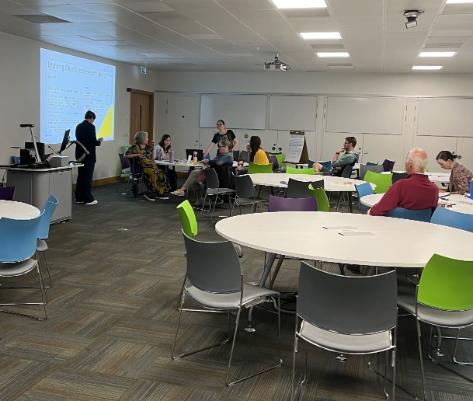TAILS - Technology-Assisted Interdisciplinary Learning and Simulation: Advancing PostGraduate Healthcare Education
Overview

This Learning Enhancement project has been funded through SATLE (Strategic Alignment of Teaching and Learning Enhancement) with the support of the National Forum / HEA.
| PROJECT TITLE: | TAILS - Technology-Assisted Interdisciplinary Learning and Simulation: Advancing Postgraduate Healthcare Education |
|---|---|
| PROJECT COORDINATORS: | Ms Siobhan Brereton, School of Nursing, Midwifery and Health Systems and Assoc Prof Tara Cusack, School of Public Health, Physiotherapy and Sports Science |
| COLLABORATORS: | Assoc Prof Rita Smith, Dr Lisa Rogers, Dr Aoife MacCormac, Mrs Ruth Charles, Prof Claire Corish, Ms Deirdre Phelan, Mr Frank Kenny, Student representatives from Nursing, Physiotherapy and Dietetics, Patient representatives. |
| TARGET AUDIENCE: | Graduate students from across 3 disciplines: Cardiovascular Nursing, Physiotherapy and Dietetics |
Background
Currently in Ireland, securing sufficient clinical education opportunities for all health and social care students has become increasingly challenging; this is compounded by a current 33% vacancy rate across healthcare professional roles. In recent years, interdisciplinary healthcare has been highlighted as a way to improve patient outcomes and develop global healthcare. Interdisciplinary education is defined as two or more disciplines coming together, in such a way that the disciplines interact with one another and have some effect on one another's perspectives. Therefore, interdisciplinary education plays an important role in developing the communication skills necessary for caregivers and professionals, and it is a component of Standards and Requirements across all healthcare education (NMBI 2016, CORU). In the case of TAILS, interdisciplinary education was coupled with simulation. Simulation-based education is the use of any simulation in the formative or summative education of healthcare professionals (Byrne et al., 2021). Simulation has three key components in terms of education delivery, pre-learning facilitated through the design and delivery of online learning, in-person simulation and finally, facilitated debriefing.
Goals
The primary aim of this project was to bring together key stakeholders to co-design a technology-assisted interdisciplinary learning tool together with two clinical simulation scenarios, reflecting clinical practice. The learning tool and clinical scenarios were then piloted with an interdisciplinary graduate cohort of students, with a view to embedding the results into the curricula for the three disciplines, physiotherapy, dietetics, and cardiac nursing.
With effective collaboration of the different groups, the goal was to improve sustainable and effective clinical education by developing an online pre-learning tool (technology component) and creating clinical scenarios (simulation), where students could participate in a simulated and safe environment. The technology component was a pre-learning resource designed to prepare students for these scenarios. The scenarios were created to provide opportunities for students to better understand their roles and responsibilities within an interdisciplinary context and to develop their communication and interpersonal skills, for example, collaboration and teamwork. The workshop was to define the pre-learning information and determine how students and staff should prepare for an interdisciplinary simulation.
Approach
Students collaborated with all elements of this project. Students from each discipline were members of the project proposal team. A literature review was undertaken initially, and this formed the basis for a World Cafe co-design process for the technology-assisted pre-learning and simulated education. Students contributed together with expert clinicians, academics, patients, and educational technologists. On completion of the co-design workshop, participants were asked for final feedback in relation to the scenarios. The interdisciplinary simulation education was rolled out as a core part of modules in the Professional Masters in Physiotherapy, MSc Dietetics and Cardiac Nursing Graduate programmes (70 students) in April 2024. Students engaged in the implementation of the simulated learning by experiencing and participating in it and providing feedback. The following questionnaires were used to gather student feedback: the Simulation Effectiveness Tool and the Interprofessional Collaborative Competencies Attainment Tool. Feedback was also sought from facilitators and the standardised participants (patient actors). A workshop for faculty was held in October 2024, where Professor Dara Byrne, National Clinical Lead for Simulation, presented, and six students from across the disciplines presented their perceptions of the simulation rollout. The findings of this work have been disseminated nationally and internationally.
Results
Deliverables
- A co-designed interdisciplinary simulation in the area of cardiovascular health. This consists of two parts: firstly, an online educational resource; secondly, two simulated clinical scenarios, enabling students to explore the role of each profession.
- A qualitative study presenting the perceptions of key stakeholders, students, facilitators, and standardised participants.
- A UCD workshop was held in October 2024 to disseminate the findings from each of the stakeholder perspectives.
- An educational video for faculty, which will be used to educate simulation facilitators.
Short Term Impacts
Students
- Improved student understanding of each discipline’s role in patient care.
- The opportunity to engage in interdisciplinary scenarios.
Faculty
- The project enabled staff across three disciplines and two schools to work together to develop simulation.
Long Term Impacts
Students
- This project has led to simulation scenarios being embedded into the curricula across the three disciplines and this will remain a core component of the programmes for the foreseeable future.
Faculty
- This project has enabled the building of relationships between faculty across the SNMHS and SPHPSS, many of whom are now participating in the development of a CHAS Strategy for simulation.
Resources
International Nursing Association for Clinical Simulation and Learning INACSL